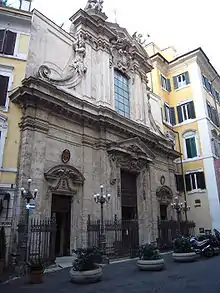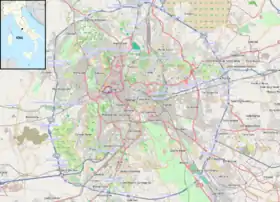Sant'Antonio dei Portoghesi
The church of Saint Anthony in Campo Marzio, known as Saint Anthony of the Portuguese (Italian: Sant'Antonio dei Portoghesi, Portuguese: Santo António dos Portugueses), is a Baroque Roman Catholic titular church in Rome, dedicated to Saint Anthony of Lisbon. The church which functions as a national church of the Portuguese community [1][2] residing in that city and pilgrims visiting Rome and the Vatican.
| Church of St. Anthony in Campo Marzio S. Antonio in Campo Marzio (in Italian) Santo António no Campo de Marte (in Portuguese) S. Antonii in Campo Martio (in Latin) | |
|---|---|
 Façade of the church of the National Church in Rome of Portugal. | |
| Religion | |
| Affiliation | Roman Catholic |
| Rite | Roman Rite |
| Ecclesiastical or organizational status | National Church in Rome of Portugal, titulus |
| Leadership | Manuel José Macário do Nascimento Clemente |
| Patron | Anthony of Lisbon |
| Location | |
| Location | Via dei Portoghesi 2,Rome |
 Shown within Rome | |
| Geographic coordinates | 41°54′7.1″N 12°28′28.1″E |
| Architecture | |
| Architect(s) | Martino Longhi the Younger, Carlo Rainaldi, Cristoforo Schor |
| Type | Church |
| Style | Baroque |
| Completed | 17th century |
| Specifications | |
| Length | 30 metres (98 ft) |
| Width | 20 metres (66 ft) |
| Website | |
| Official website | |
Established as titulus S. Antonii in Campo Martio in 2001, it is currently assigned to Cardinal Manuel José Macário do Nascimento Clemente.
History
The national church of the Portuguese people was designed by Martino Longhi the Younger (1638), Carlo Rainaldi (1657), and finally by Cristoforo Schor (1697), replacing a 15th-century church built under the initial patronage of Cardinal António Martins de Chaves. The ribbed dome (1674–76) was designed by Rainaldi.
The ceiling is stuccoed by Pompeo Gentile and frescoed by Salvatore Nobili. In the first chapel, the neoclassic monument to Alexandre de Sousa Holstein was sculpted by Antonio Canova in 1806; the second chapel has a Baptism of Christ by Giacinto Calandrucci, and a Circumcision of John the Baptist by Nicolas Lorrain. A second monument in the chapel is also by Calandrucci.
The main altar has an Apparition of the Virgin. Another chapel includes a funerary monument to ambassador Manuel Pereira de Sampaio by Pietro Bracci from 1750. The second chapel has three artworks by Lorrain: a Nativity, Adoration by the Magi, and Repose in Egypt. The first chapel on the left has an altarpiece of Madonna with child and Saints Antonio of Padua and Francis by Antoniazzo Romano.
Cardinal-Priests
Since the 2001 consistory of Pope John Paul II, the church has been used as a titular church.
- José Policarpo (21 February 2001 – 12 March 2014)
- Manuel José Macário do Nascimento Clemente (14 Feb 2015 – present)
References
- Dra. Fernanda Azuaje-Fidalgo (2011-12-19). "A Presença Portuguesa em Roma na Real Igreja, Casa e Hospital de Santo António dos Portugueses na época moderna - Uma visita guiada pela História e pelo Património". Fernanda Azuaje-Fidalgo. Universidade do Porto. Retrieved 2020-08-25.
- A Presença Portuguesa em Roma na Real Igreja, Casa e Hospital de Santo António dos Portugueses na época moderna. Tese da Dra. Fernanda Azuaje-Fidalgo no Repositório da Universidade do Porto.
External links
![]() Media related to Sant'Antonio in Campo Marzio at Wikimedia Commons
Media related to Sant'Antonio in Campo Marzio at Wikimedia Commons